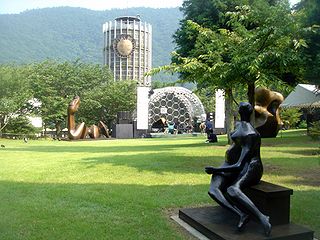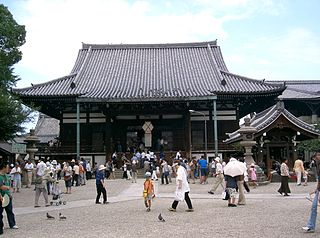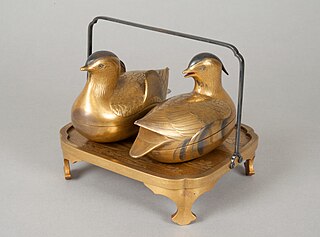 W
WThe sculpture of Japan started from the clay figure.Towards the end of the long Neolithic Jōmon period, some pottery vessels were "flame-rimmed" with extravagant extensions to the rim that can only be called sculptural, and very stylized pottery dogū figures were produced, many with the characteristic "snow-goggle" eyes. During the Kofun period of the 3rd to 6th century CE, haniwa terracotta figures of humans and animals in a simplistic style were erected outside important tombs. The arrival of Buddhism in the 6th century brought with it sophisticated traditions in sculpture, Chinese styles mediated via Korea. The 7th-century Hōryū-ji and its contents have survived more intact than any East Asian Buddhist temple of its date, with works including a Shaka Trinity of 623 in bronze, showing the historical Buddha flanked by two bodhisattvas and also the Guardian Kings of the Four Directions.
 W
WAsakura Museum of Sculpture or Asakura Choso Museum is a museum in Tokyo that showcases the sculptures and life work of Fumio Asakura (1883-1965). The art museum is located specifically in the Yanaka neighborhood of Taito, in Tokyo. The museum opened in 1967 after Asakura's death.
 W
WThe seated wooden statue of Dainichi Nyorai at the Shingon temple of Enjō-ji in Nara is the earliest and best-substantiated work by Japanese master sculptor Unkei. An inscription on the pedestal records that he began work on the piece in 1175 and brought it to completion the following year. The sculpture has been designated a National Treasure. Unkei's next documented works, from the early 1180s, were commissioned by military leaders prominent in the ensuing Kamakura shogunate, for temples in eastern Japan. These works are physically more massive and powerful, as are his giant Niō at Tōdai-ji. By contrast, in this early work Unkei employed a more "gentle" or "tranquil" style.
 W
WThe so-called "dogū with palms pressed together" is a Japanese dogū or clay figurine of the late Jōmon period. Excavated from the Kazahari I Site in Hachinohe, Aomori Prefecture, it is exhibited at the nearby Korekawa Jōmon Kan. Alongside "Hollow Dogū" from Hokkaidō, "Jōmon Goddess" from Yamagata Prefecture, and "Jōmon Venus" and "Masked Goddess" from Nagano Prefecture, it is one of five dogū that have been designated National Treasures.
 W
WThe Hakone Open-Air Museum is Japan's first open-air museum, opened in 1969 in Hakone in Ashigarashimo District, Kanagawa Prefecture, Japan. It has collections of artworks made by Picasso, Henry Moore, Taro Okamoto, Yasuo Mizui, Churyo Sato, Susumu Shingū and many others, featuring over a thousand sculptures and works of art. The museum is affiliated with the Fujisankei Communications Group media conglomerate.
 W
WHōgyū Jizō (放牛地蔵) are Japanese stone statues; mostly of Ksitigarbha and other kinds of stone statues made by Buddhist monk Hōgyū between 1722 and 1732 in Kumamoto, Japan. When Hōgyū was about 14, in 1686, his father was killed by a samurai. Later he made stone statues for the repose of the soul of his father.
 W
WThe so-called "Hollow Dogū" is a Japanese dogū or clay figurine of the Late Jōmon period. A chance find from what was to become the Chobonaino Site in Hakodate, Hokkaidō, it is exhibited at the Hakodate Jōmon Culture Center. it is one of five dogū that have been designated National Treasures. The other four include "Dogū with palms pressed together" from Aomori Prefecture, "Jōmon Goddess" from Yamagata Prefecture, and "Jōmon Venus" and "Masked Goddess" from Nagano Prefecture. It is also the first and, to date, only National Treasure in Hokkaidō.
 W
WIsshin-ji (一心寺) is a Pure Land Buddhist temple in Osaka, Japan. Starting in the Meiji period, thirteen images have been formed, each incorporating the ashes of tens of thousands of devotees. The annual burial ceremony on 21 April in turn draws tens of thousands of worshippers.
 W
WThe Jūroku Rakan Iwa (十六羅漢岩) or "Sixteen Rakan Rocks" is a monument to the local fishermen in Yuza, Yamagata Prefecture, Japan. Carved from volcanic rock by a Buddhist monk between 1864 and 1868, there are in total twenty-two figures: the Sixteen Arhats along with Shakyamuni, Manjusri, Fugen and his consort, Avalokitesvara, and the Sarira. A little to the south of the carvings is Dewa Futami, or the Wedded rocks of Dewa Province.
 W
WThe Kodaira Hirakushi Denchu Art Museum is an art museum in the city of Kodaira in western Tokyo, Japan, dedicated to the life and work of Japanese master wood sculptor Hirakushi Denchū (1872–1979). The museum preserves the last home and studio of Denchu, where he moved in 1970, and has a purpose-built exhibition annex building housing many of the sculptor's works.
 W
WKumano magaibutsu (熊野磨崖仏) is a group of relief sculptures of the late Heian or early Kamakura period in Bungotakada, Ōita Prefecture, Japan. The image of Fudō Myōō measures 8.07 m and that of Dainichi Nyorai 6.82 m. The carvings are an Important Cultural Property and the area has been designated an Historic Site.
 W
WIn the mid-6th century, the introduction of Buddhism from Korea (Baekje) to Japan resulted in a revival of Japanese sculpture. Buddhist monks, artisans and scholars settled around the capital in Yamato Province and passed their techniques to native craftsmen. Consequently, early Japanese sculptures from the Asuka and Hakuhō periods show strong influences of continental art, which initially were characterized by almond-shaped eyes, upward-turned crescent-shaped lips and symmetrically arranged folds in the clothing. The workshop of the Japanese sculptor Tori Busshi, who was strongly influenced by the Northern Wei style, produced works which exemplify such characteristics. The Shakyamuni triad and the Guze Kannon at Hōryū-ji are prime examples. By the late 7th century, wood replaced bronze and copper. By the early Tang dynasty, greater realism was expressed by fuller forms, long narrow slit eyes, softer facial features, flowing garments and embellishments with ornaments such as bracelets and jewels. Two prominent examples of sculptures of this period are the Shō Kannon at Yakushi-ji and the Yumechigai Kannon at Hōryū-ji.
 W
WThe Metropolitan Museum of Art has a pair of 17th-century Japanese lacquered wood incense boxes in the shape of mandarin ducks in its collection.
 W
WThe standing bronze statue of Shaka at Birth at Tōdai-ji in the city of Nara in Japan, along with the lustration basin in which the image stands, are of the type used in the annual celebrations of the Buddha's birth on 8 April. The statue and its basin date to the Nara period and have been designated National Treasures.
 W
WIn traditional Japanese culture, suiseki (水石) are small naturally occurring or shaped rocks which are appreciated for their aesthetic or decorative value. They are similar to Chinese scholar's rocks.
 W
WThe Tachibana Shrine , also referred to as the Lady Tachibana Shrine, is a miniature shrine owned by the Hōryū-ji temple complex of Nara Prefecture, Japan. Its precise date of construction is unknown, but it is thought to have been created a little later than its counterpart the Tamamushi Shrine. The sculptures inside are dated to the years around 710 and have been designated a National Treasure.
 W
WUeno Daibutsu (上野大仏) was an Edo-period giant seated statue of Shaka Nyorai in what is now Ueno Park, Tokyo, Japan. Of bronze and dating to 1631, it was restored after earthquake damage in 1640, a fire in 1841, and again after the 1855 Edo earthquake. Heavily damaged during the 1923 Great Kantō earthquake, when the head was toppled, much of its bulk was melted down for reuse during the Pacific War. In 1972 the face, stored in Kan'ei-ji, was put on display in its former location.
 W
WThe Jōmon Venus is a dogū, a humanoid clay female figurine from the Middle Jōmon period (3,000–2,000 BC), discovered in 1986 in Chino, Nagano Prefecture, Japan. It was designated a National Treasure in 1995, the first Jōmon-period artifact to be so designated.